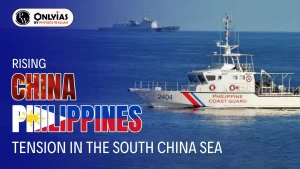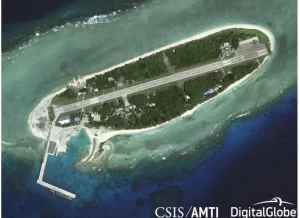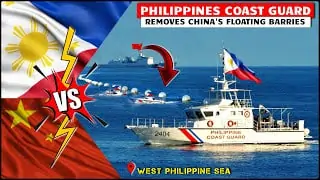Scarborough Shoal | Best #1 Rising Tension Philippines&China

Rising China Philippines Tension In The South China Sea
Table of Contents
Trick Takeaways
- Explore the legal basis of territorial cases over Scarborough Shoal, highlighting the contending analyses of historic civil liberties and UNCLOS stipulations.
- Examine the ramifications of the Scarborough Shoal dispute on local safety, consisting of the role of the United States and other stakeholders in keeping stability in the South China Sea.
- Analyze the shoal’s ecological and economic significance, particularly in terms of marine biodiversity and prospective oil and gas gains.
- Testimonial past diplomatic initiatives to solve the Scarborough Shoal dispute and assess leads for future resolution.
Intro to Scarborough Shoal
In the heart of the South China Sea, the Scarborough Shoal is a small yet tactically considerable maritime function that has become a centerpiece in the territorial conflicts between the Philippines and China.
This rough outcrop, additionally known as Panatag Shoal in the Philippines and Huangyan Island in China, has been the center of diplomatic tension and geopolitical maneuvering for numerous decades.
Geographical Introduction of Scarborough Shoal
The Scarborough Shoal is a triangular-shaped chain of reefs and rocks encompassing a central shallows.
It lies around 120 nautical miles west of the Philippine island of Luzon, well within the Philippines’ particular financial area (EEZ) as specified by the United Nations Convention on the Law of the Sea (UNCLOS).
Despite its dimension—just about 150 square kilometers—the shoal is substantial due to its calculated area and potential resource wealth.
Historical Context of Territorial Cases by the Philippines and China

The historical backdrop of the Scarborough Shoal disagreement traces back to the mid-20th century.
The Philippines and China assert historical ties to the shoal, citing maps and files dating back centuries.
Nevertheless, the contemporary dispute intensified in 2012 when a standoff happened between Philippine and Chinese vessels over angling rights and accessibility to the location.
This case reignited long-standing tensions over territorial cases in the South China Sea.
Legal Disputes over Scarborough Shoal
The Scarborough Shoal conflict between the Philippines and China is not just a geopolitical standoff; it’s a complicated legal challenge embedded in worldwide maritime regulation, mainly controlled by the United Nations Convention on the Law of the Sea (UNCLOS). Let’s explore this lawful disagreement’s complexities and impact on global connections.
Evaluation of Clashing Insurance Claims under UNCLOS
UNCLOS typically called the “constitution for the oceans,” provides a framework for solving maritime conflicts among nations. The core of the Scarborough Shoal disagreement depends on analyzing UNCLOS stipulations about territorial waters, unique economic zones (EEZs), and historic rights.
China declares historical sovereignty over Scarborough Shoal based on old maps and documents, asserting it as an intrinsic component of its region. On the other hand, the Philippines argues that the shoal falls within its 200-nautical-mile EEZ, making it based on its sovereign rights over resources based on UNCLOS.
The conflicting claims focus on UNCLOS’ interpretations of territorial seas, EEZs, and delineating maritime limits. These meanings’ legal intricacies have sustained the recurring conflict, highlighting the complexities of applying global law to overlapping insurance claims.
Influence of International Arbitration and Legal Rulings
In 2013, the Philippines brought its conflict with China over Scarborough Shoal to an international tribunal under UNCLOS. The Permanent Court of Settlement (PCA) in The Hague delivered a site ruling in 2016, invalidating China’s significant cases in the South China Sea, consisting of Scarborough Shoal.
The PCA’s ruling clarified numerous bottom lines:
- Scarborough Shoal is a rock, not an island, that can generate its own EEZ.
- China’s historical insurance claims based upon the “nine-dash line” were irregular with UNCLOS.
- The tribunal supported the Philippines’ rights to fish and exploit sources within its EEZ, including Scarborough Shoal.
- Nonetheless, China declined the tribunal’s territory and refused to identify the judgment, leading to continued stress and defiance of international lawful standards.
The PCA’s decision considerably influenced the discourse on maritime disagreements in the area, highlighting the relevance of global legislation in dealing with such disputes. Nevertheless, the obstacle remains in translating legal decisions into substantial polite remedies.
Philippines-China Conflict Over Scarborough Shoal
The Scarborough Shoal dispute between the Philippines and China has witnessed a series of significant events that have exacerbated tensions in the South China Sea. This conflict is not merely about territorial claims but also reflects broader geopolitical ambitions and strategic interests. Let’s explore the timeline of key events and the military and diplomatic maneuvers that have contributed to the escalating tensions.
Timeline of Significant Events Leading to Heightened Tensions
Here’s a chronological overview of notable events that have shaped the Scarborough Shoal conflict:
| Year | Events |
|---|---|
| 1997 | Chinese forces begin occupying Scarborough Shoal, leading to intermittent standoffs with Filipino fishermen. |
| 2012 | A standoff between Philippine and Chinese vessels at Scarborough Shoal escalates tensions. |
| 2013 | Philippines files a case against China under UNCLOS arbitration, challenging its claims in the South China Sea. |
| 2016 | The Permanent Court of Arbitration rules in favor of the Philippines, rejecting China’s expansive claims. |
| 2018 | Reports emerge of increased Chinese military presence and construction activities in the area. |
| 2020 | Chinese coast guard vessels block Filipino fishermen from accessing Scarborough Shoal. |
These events underscore the persistent nature of the conflict and the stakes involved for both countries.
Military and Diplomatic Maneuvers in the Region
The Scarborough Shoal dispute has been marked by military posturing and diplomatic maneuvering, reflecting the strategic importance of the South China Sea:
- Military Presence: China has bolstered its military presence around Scarborough Shoal, deploying coast guard vessels and conducting naval patrols. This militarization has raised concerns among regional neighbors and the international community.
- Diplomatic Initiatives: The Philippines has pursued diplomatic avenues to resolve the dispute, including legal arbitration under UNCLOS. However, China’s refusal to accept the arbitration ruling has strained bilateral relations.
- Regional Alliances: Both countries have sought support from regional allies and international partners. The United States, in particular, has reiterated its commitment to the Philippines’ security amid tensions in the South China Sea.
- Incidents at Sea: There have been reports of confrontations between Philippine and Chinese vessels near Scarborough Shoal, highlighting the risk of maritime incidents escalating into broader conflict.
Environmental and Ecological Concerns Amidst
Beyond the geopolitical and legal dimensions, the Scarborough Shoal dispute carries profound environmental and ecological implications.
The fragile marine ecosystem surrounding this contested area faces significant challenges due to ongoing disputes and human activities.
Let’s delve into the importance of Scarborough Shoal’s marine ecosystem and the environmental impacts of the conflict.
Importance of Scarborough Shoal’s Marine Ecosystem
The Scarborough Shoal is more than just a territorial flashpoint; it is a vital marine habitat teeming with biodiversity. The shoal’s rocky reefs and shallow waters support a diverse array of marine life, including coral reefs, fish species, and migratory birds. This rich ecosystem serves as a breeding ground and nursery for various marine organisms, contributing to regional biodiversity and sustaining local fishing communities.
Additionally, Scarborough Shoal’s strategic location within the South China Sea makes it a crucial area for marine research and conservation efforts. Protecting this ecosystem is not only essential for environmental sustainability but also for the livelihoods of those dependent on its resources.
Environmental Impacts of Ongoing Disputes and Human Activities
Unfortunately, the Scarborough Shoal dispute and associated human activities have taken a toll on its delicate ecosystem:
- Overfishing: The presence of foreign fishing vessels, including from China, has led to overfishing in the area. This excessive fishing pressure threatens fish stocks and disrupts the natural balance of the marine ecosystem.
- Destruction of Coral Reefs: Reports indicate coral reef destruction caused by illegal fishing practices, including the use of dynamite and cyanide. These destructive methods not only harm marine life but also degrade the habitat necessary for sustaining biodiversity.
- Pollution and Marine Debris: Increased maritime activities, including military patrols and commercial shipping, contribute to pollution and marine debris accumulation in the waters surrounding Scarborough Shoal. Oil spills, garbage dumping, and other forms of pollution pose risks to marine life and ecosystems.
- Habitat Loss and Degradation: Ongoing disputes and territorial tensions have hindered efforts to establish marine protected areas and conservation measures around Scarborough Shoal. This lack of protection exacerbates habitat loss and degradation, further threatening the long-term health of the marine ecosystem.
Diplomatic Dance: Navigating Tensions Between the Philippines and China Over Scarborough Shoal

The diplomatic efforts and negotiations surrounding the Scarborough Shoal dispute have been a delicate and intricate dance, reflecting the complexities of international relations in the South China Sea. Let’s unravel the dynamics of diplomatic engagements and the pivotal role of regional and international mediators in seeking conflict resolution.
Analysis of Diplomatic Engagements Between the Philippines and China
The interactions between the Philippines and China regarding Scarborough Shoal have been characterized by a mix of dialogue, confrontation, and diplomatic maneuvers:
- Bilateral Talks: Despite tensions, both countries have engaged in bilateral discussions aimed at finding common ground. These talks have covered issues ranging from fisheries management to broader territorial disputes.
- Arbitration under UNCLOS: The Philippines pursued legal arbitration under the United Nations Convention on the Law of the Sea (UNCLOS) to challenge China’s claims in the South China Sea, including Scarborough Shoal. The landmark ruling by the Permanent Court of Arbitration (PCA) in 2016 marked a significant diplomatic milestone, although China refused to recognize the decision.
- Multilateral Forums: Regional and international forums, such as ASEAN (Association of Southeast Asian Nations) and the East Asia Summit, have provided platforms for dialogue and mediation. These forums aim to promote peaceful resolutions and adherence to international law.
Role of Regional and International Mediators in Conflict Resolution
The Scarborough Shoal dispute has attracted the attention of various mediators seeking to facilitate dialogue and negotiation:
| Mediators | Role |
|---|---|
| United States | The U.S. has supported the Philippines’ position and advocated for peaceful resolutions through diplomatic channels. |
| ASEAN | ASEAN has played a role in promoting regional cooperation and dialogue among member states, including on maritime issues. |
| United Nations | The United Nations has emphasized the importance of upholding international law and peaceful dispute resolution in the South China Sea. |
| Track II Diplomacy Groups | Non-governmental organizations and expert groups have conducted unofficial dialogues and backchannel communications to foster understanding and trust between parties. |
These mediators play a critical role in facilitating communication, building trust, and exploring avenues for conflict resolution beyond traditional diplomatic channels.
Current Status and Future Outlook: The Scarborough Shoal Conflict
The Scarborough Shoal dispute between the Philippines and China continues to be a focal point of tension in the South China Sea, with recent developments shaping the current situation and influencing the future outlook for resolution and regional stability. Let’s delve into the latest updates and prospects for the future.
Overview of Recent Developments and Current Situation at Scarborough Shoal
Recent developments at Scarborough Shoal highlight the ongoing complexities of the dispute:
- Increased Presence: China has maintained a consistent presence around Scarborough Shoal, deploying coast guard vessels and surveilling the area. This continued presence underscores China’s assertion of sovereignty despite international legal rulings.
- Restrictions on Access: Filipino fishermen have faced challenges accessing traditional fishing grounds near Scarborough Shoal due to Chinese patrols and restrictions. This has had significant implications for the livelihoods of local fishing communities.
- Diplomatic Engagement: The Philippines has pursued diplomatic initiatives aimed at resolving the dispute through dialogue and negotiation. Efforts have been made to engage with regional partners and international stakeholders to find peaceful solutions.
- Geopolitical Context: The Scarborough conflict occurs within the broader context of geopolitical competition in the South China Sea, involving multiple claimant states and external powers with strategic interests in the region.
Prospects for Resolution and Implications for Regional Stability
Looking ahead, the resolution of the Scarborough conflict carries significant implications for regional stability and international relations:
Diplomatic Pathways: Diplomatic engagement remains crucial for finding a peaceful resolution to the dispute. Both the Philippines and China have expressed willingness to explore diplomatic solutions, albeit with challenges posed by divergent interpretations of sovereignty and legal frameworks.
International Law and UNCLOS: Upholding international law, particularly the rulings under UNCLOS, is essential for establishing a rules-based order in the South China Sea. Efforts to encourage compliance with legal norms and agreements can contribute to confidence-building measures.
Regional Cooperation: Strengthening regional cooperation through platforms like ASEAN and the East Asia Summit is key to fostering trust and promoting dialogue among stakeholders. Building consensus on maritime issues and dispute resolution mechanisms can enhance stability.
Implications for Security: This Shoal dispute has broader implications for regional security dynamics, including the role of major powers like the United States and implications for freedom of navigation in international waters.
Frequently Asked Questions (FAQs)
What is the Scarborough Shoal dispute?
The dispute involves competing territorial claims between the Philippines and China over a strategic maritime feature located in the South China Sea. Both countries assert sovereignty over the area, leading to ongoing tensions and diplomatic standoffs.
Why is Scarborough Shoal significant?
This may holds strategic importance due to its rich marine biodiversity, potential oil and gas reserves, and its location along crucial shipping routes in the South China Sea. Control over the shoal could provide access to valuable resources and enhance maritime influence.
What are the key points of contention between the Philippines and China?
The primary points of contention revolve around sovereignty claims and fishing rights. The Philippines argues that Scarborough Shoal falls within its exclusive economic zone (EEZ), as defined by international law. However, China disputes this claim, citing historical ties and sovereignty.
What legal frameworks govern the Scarborough Shoal dispute?
The dispute is influenced by international maritime law, particularly the United Nations Convention on the Law of the Sea (UNCLOS). Both the Philippines and China have invoked UNCLOS provisions to support their respective claims and have engaged in legal arbitration to seek resolution.
What efforts have been made to resolve the Scarborough Shoal dispute?
Diplomatic efforts, including bilateral negotiations, legal arbitration, and involvement of regional and international mediators, have been undertaken to resolve the dispute. However, tensions persist, and a lasting resolution remains elusive, with implications for regional stability and maritime security.
Conclusion
The dispute underscores the intricate challenges of managing maritime disputes in the South China Sea. The conflict between the Philippines and China, driven by competing territorial claims and strategic interests, has persisted despite diplomatic efforts and legal rulings.
The ongoing tensions at Scarborough Shoal have broader implications for regional stability, international law, and maritime security.
Moving forward, sustained dialogue, adherence to international norms like UNCLOS, and enhanced regional cooperation are essential to pave the way for peaceful resolutions and foster stability in this critical maritime region.
Efforts to find common ground and promote mutual understanding remain paramount to transform the Scarborough Shoal from a point of contention into a symbol of cooperation and shared prosperity.
YOU MAY ALSO LIKE:
- EL NIÑO 2024
- NBA Playoffs
- Sultan Kudarat Tourists Spot
- Refreshing Products
- Top 10 Biggest Company in the Philippines
- Horosope
ADVERTISEMENT


Nel Wiesenberg is a multifaceted individual known for his diverse career as a technical writer, author, and former professional poker player. His journey in the world of gambling began with a decade-long stint as a professional poker player before transitioning into technical writing. Wiesenberg’s contributions to the gambling community are extensive, having written for various publications over the years.
During his tenure as a professional poker player, Wiesenberg made a significant impact on the industry. He wrote for the original Gambling Times magazine, focusing on keno and poker, showcasing his expertise in these games. Additionally, he had regular columns in publications such as Poker Player and Pan Player +, a magazine catering to Panguingue players. Wiesenberg’s writing extended beyond gambling, with contributions to Dr. Dobb’s Journal, a computer magazine, and A+, a magazine for Apple computer users. His articles also appeared in publications like PC Publishing, Micro Times, Infoworld, and more.